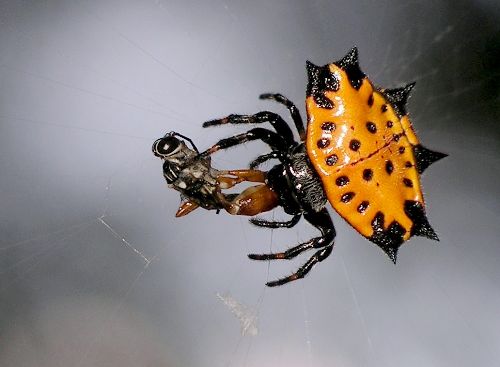by Valerie
September, 2007Spiny-backed Orbweaver
An easy choice for featured beast this month is the spiny-backed orbweaver (Gasteracantha cancriformis). This spider is rather common every year in our area, and a few are often seen even in the middle of winter, but this year their population has exploded. Any grove of trees probably contains numerous individuals, and their lovely, symmetrical webs can be found in many backyards. While nice to look at, they are a bother if you want to walk through their territory, as the webs are extremely big compared to the small spider size, often stretching across four feet or more. Although the spiders add little tufts of silk to the edges of their webs, they can still be almost invisible if the light doesn't hit them just right. When the web is destroyed, such as happens when a human blunders into it, the spider simply curls up and remains still, probably wondering what massive disaster just struck. These spiders are not considered poisonous and, even after making inadvertent contact with quite a number, I've never been bitten. Their spiny bodies do get caught easily in hair and clothes, though, so they can cause a bit of panic for the arachnophobic. At no more than 1/2 inch in width, these are not large spiders. Most are smaller. The males are rarely seen and are quite tiny by comparison to the familiar females. Spiny-backed orbweavers come in several colors, but are all the same species. The base color of the body is always black, but the abdomen can be white, yellow or orange (young orange individuals are sometimes a deep red). Another form, which I've seen in Florida but not here in Texas, has a white body and large red, rather than black, spines. One color phase may dominate in any particular location. The fine webs of these orbweavers are very efficient for catching small flying insects, including the burgeoning mosquito population that has accompanied our extremely wet summer. It is obvious that a number of these webs in one's yard can only help reduce the pest problem in an environmentally friendly manner. |
(A photo gallery located in "larvalbug eye" provides more photos and information on spiny-backed orbweavers.)